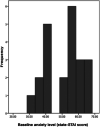Effects of active musical engagement during physical exercise on anxiety, pain and motivation in patients with chronic pain
- PMID: 36483944
- PMCID: PMC9722724
- DOI: 10.3389/fpain.2022.944181
Effects of active musical engagement during physical exercise on anxiety, pain and motivation in patients with chronic pain
Abstract
The experience of anxiety is central to the development of chronic pain. Music listening has been previously shown to exert analgesic effects. Here we tested if an active engagement in music making is more beneficial than music listening in terms of anxiety and pain levels during physical activity that is often avoided in patients with chronic pain. We applied a music feedback paradigm that combines music making and sports exercise, and which has been previously shown to enhance mood. We explored this method as an intervention to potentially reduce anxiety in a group of patients with chronic pain (N = 24, 20 female and 4 men; age range 34-64, M = 51.67, SD = 6.84) and with various anxiety levels. All participants performed two conditions: one condition, Jymmin, where exercise equipment was modified with music feedback so that it could be played like musical instruments by groups of three. Second, a conventional workout condition where groups of three performed exercise on the same devices but where they listened to the same type of music passively. Participants' levels of anxiety, mood, pain and self-efficacy were assessed with standardized psychological questionnaires before the experiment and after each condition. Results demonstrate that exercise with musical feedback reduced anxiety values in patients with chronic pain significantly as compared to conventional workout with passive music listening. There were no significant overall changes in pain, but patients with greater anxiety levels compared to those with moderate anxiety levels were observed to potentially benefit more from the music feedback intervention in terms of alleviation of pain. Furthermore, it was observed that patients during Jymmin more strongly perceived motivation through others. The observed diminishing effects of Jymmin on anxiety have a high clinical relevance, and in a longer term the therapeutic application could help to break the Anxiety Loop of Pain, reducing chronic pain. The intervention method, however, also has immediate benefits to chronic pain rehabilitation, increasing the motivation to work out, and facilitating social bonding.
Keywords: anxiety; chronic pain; motivation; musical agency; musical feedback; physical activity.
© 2022 Schneider, Egle, Klinger, Schulz, Villringer and Fritz.
Conflict of interest statement
TF is a founding member of the start-up Jymmin GmbH that tries to make music feedback technology available in rehabilitation. TF has no formal role in the GmbH but owns shares. The remaining authors declare that the research was conducted in the absence of any commercial or financial relationships that could be construed as a potential conflict of interest.
Figures







Similar articles
-
Musical feedback during exercise machine workout enhances mood.Front Psychol. 2013 Dec 10;4:921. doi: 10.3389/fpsyg.2013.00921. eCollection 2013. Front Psychol. 2013. PMID: 24368905 Free PMC article.
-
The Band Effect-Physically Strenuous Music Making Increases Esthetic Appreciation of Music.Front Neurosci. 2016 Oct 17;10:448. doi: 10.3389/fnins.2016.00448. eCollection 2016. Front Neurosci. 2016. PMID: 27799893 Free PMC article.
-
Musical feedback system Jymmin® leads to enhanced physical endurance in the elderly-A feasibility study.Front Sports Act Living. 2022 Aug 11;4:915926. doi: 10.3389/fspor.2022.915926. eCollection 2022. Front Sports Act Living. 2022. PMID: 36032261 Free PMC article.
-
Components of Active Music Interventions in Therapeutic Settings-Present and Future Applications.Brain Sci. 2022 May 10;12(5):622. doi: 10.3390/brainsci12050622. Brain Sci. 2022. PMID: 35625009 Free PMC article. Review.
-
Nursing music intervention: A systematic mapping study.Complement Ther Clin Pract. 2019 May;35:109-120. doi: 10.1016/j.ctcp.2019.02.007. Epub 2019 Feb 7. Complement Ther Clin Pract. 2019. PMID: 31003646
Cited by
-
Using music as a mood regulator in everyday life is associated with unfavourable health and fitness outcomes in overweight adults.PLoS One. 2025 Feb 27;20(2):e0317607. doi: 10.1371/journal.pone.0317607. eCollection 2025. PLoS One. 2025. PMID: 40014605 Free PMC article.
-
The psychophysiology of music-based interventions and the experience of pain.Front Psychol. 2024 May 10;15:1361857. doi: 10.3389/fpsyg.2024.1361857. eCollection 2024. Front Psychol. 2024. PMID: 38800683 Free PMC article. Review.
-
Exploring Musical Feedback for Gait Retraining: A Novel Approach to Orthopedic Rehabilitation.Healthcare (Basel). 2025 Jan 14;13(2):144. doi: 10.3390/healthcare13020144. Healthcare (Basel). 2025. PMID: 39857172 Free PMC article.
References
-
- Pickering G, Gibson S. Pain, emotion and cognition: A Complex nexus. Switzerland: Springer International Publishing; (2015).
-
- Simmonds M, Turner B. (502) long term, high dose opioids in veterans with chronic pain: are there benefits or just burdens? J Pain. (2014) 15(4):S101. 10.1016/j.jpain.2014.01.414 - DOI
LinkOut - more resources
Full Text Sources

